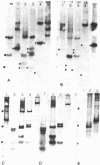Abstract
Gliosis (hyperplasia and hypertrophy of astrocytes), the fundamental response of the central nervous system to tissue destruction, typically becomes apparent only several weeks after injury. The biochemical hallmark of this response is a marked accumulation of the specific astrocyte intermediate filament glial fibrillary acidic protein (GFAP). To date despite its importance, the mechanisms of GFAP gene regulation have not been studied in any developmental or pathological system to our knowledge, and the molecular signals for GFAP mRNA and protein accumulation are not defined. In Creutzfeldt-Jakob disease, a progressive dementing illness caused by an "unconventional agent," we find steadily increasing elevations of GFAP mRNA throughout the later stages of disease, using two independent GFAP cDNA clones, representing the entire insert or the 3'-noncoding region (pScr-1). The accumulation of GFAP, assessed immunocytochemically, follows GFAP mRNA elevation. A 5-fold stimulation of GFAP gene expression precedes the development of florid histologic lesions in the cerebrum, and in the cerebellum 5- to 6-fold increases occurred with no detectable spongiform changes at any time during disease. Therefore, these GFAP changes cannot be simply a response to neuronal damage. These effects are directly or indirectly caused by high local concentrations of agent and possibly involve a humoral factor.
Full text
PDF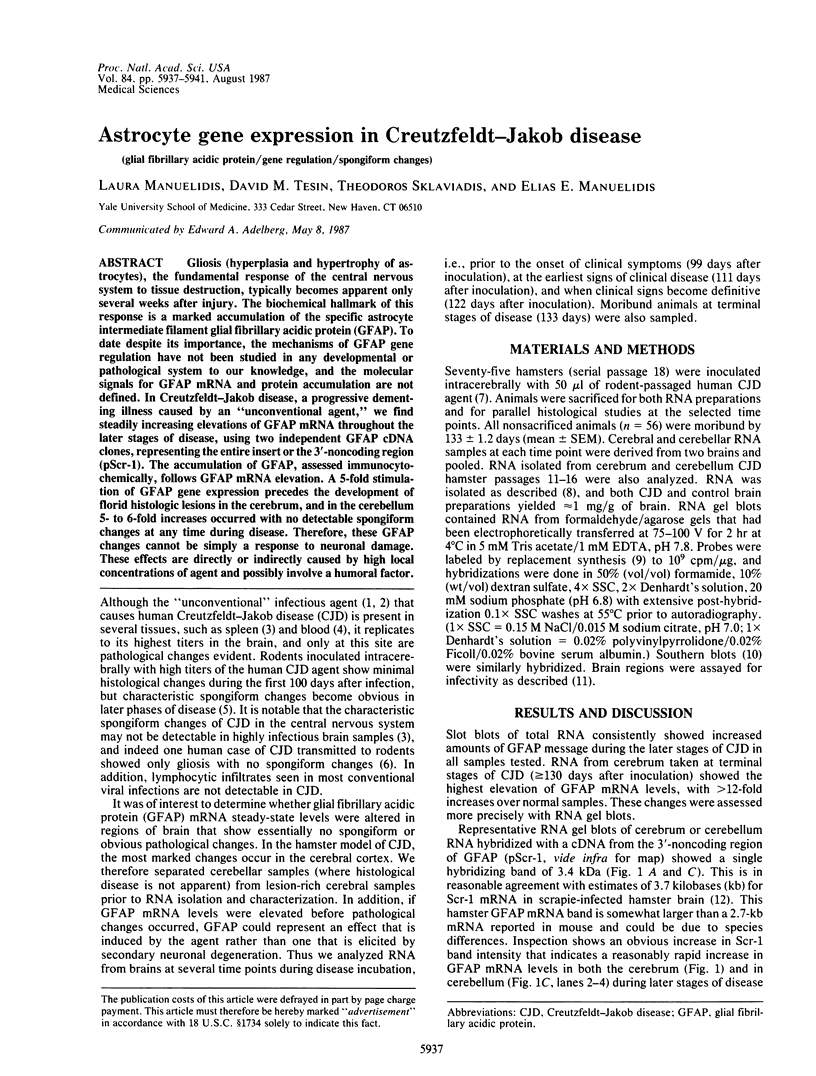
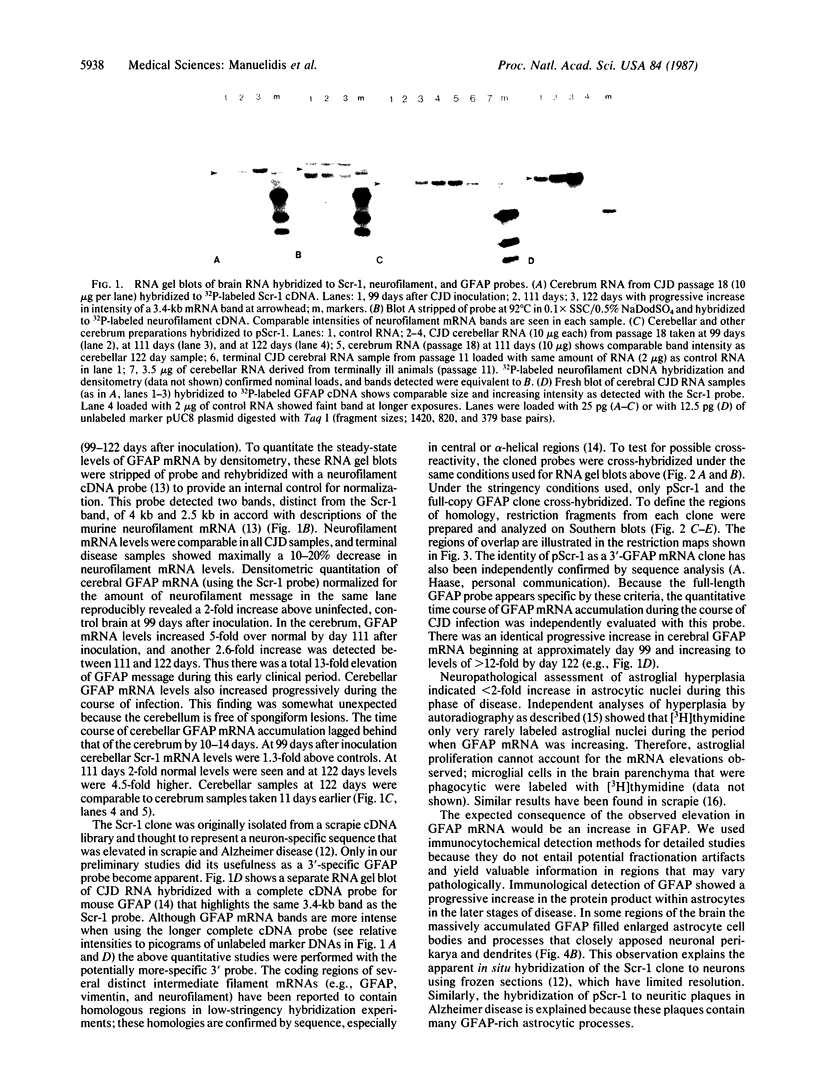
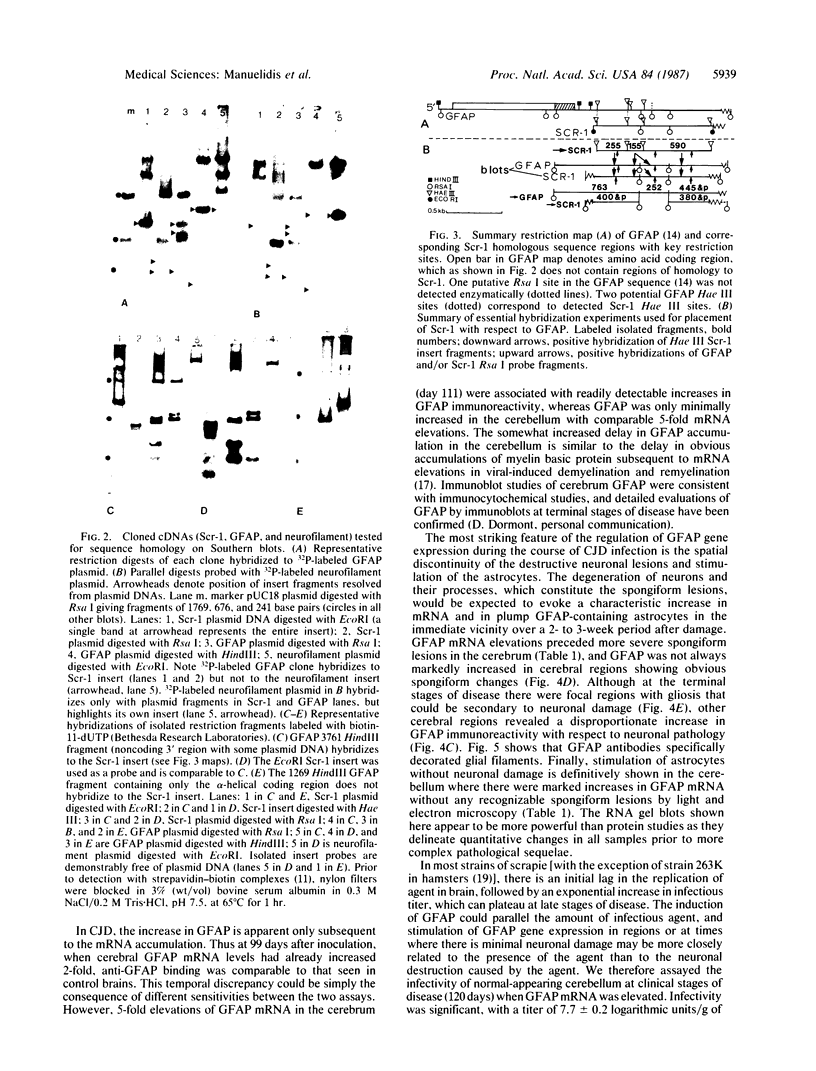
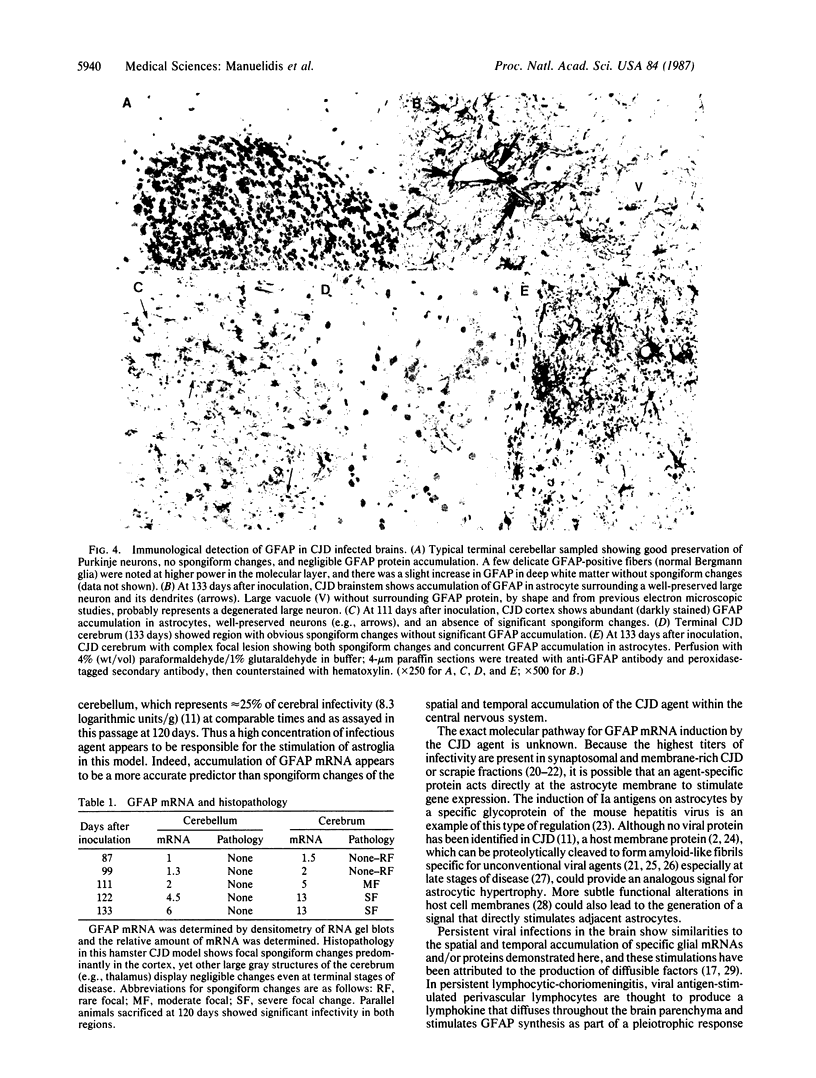
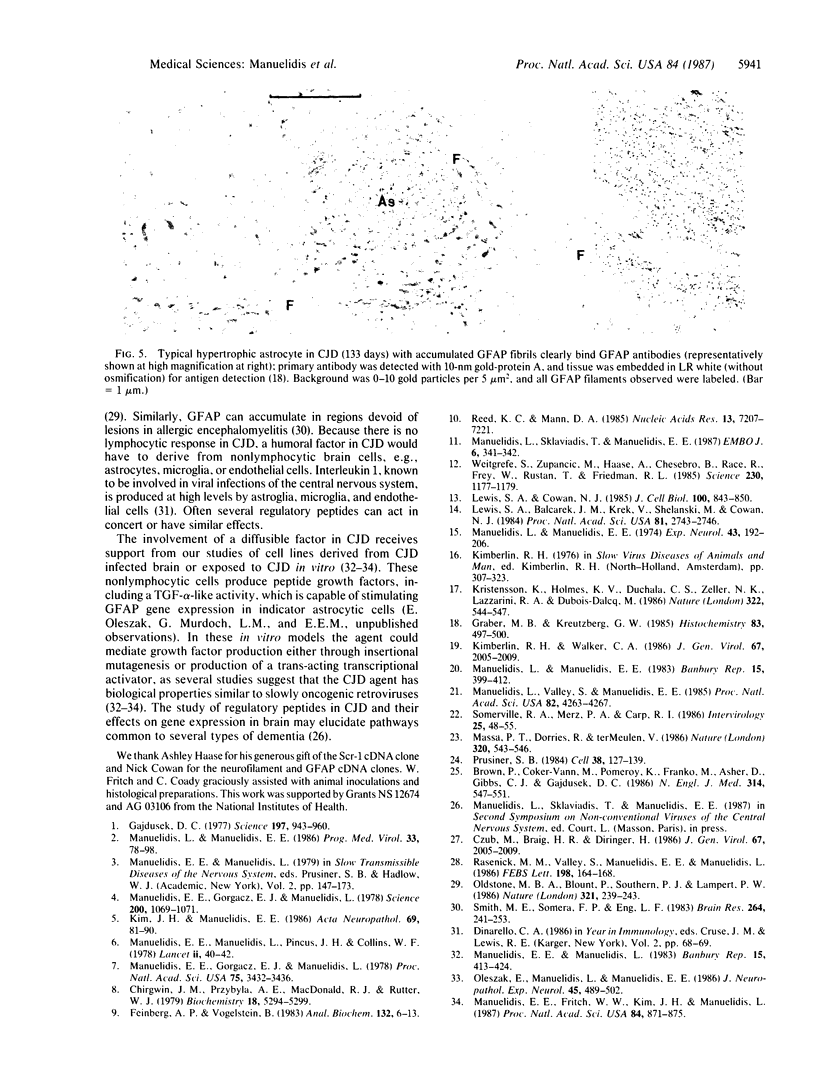
Images in this article
Selected References
These references are in PubMed. This may not be the complete list of references from this article.
- Brown P., Coker-Vann M., Pomeroy K., Franko M., Asher D. M., Gibbs C. J., Jr, Gajdusek D. C. Diagnosis of Creutzfeldt-Jakob disease by Western blot identification of marker protein in human brain tissue. N Engl J Med. 1986 Feb 27;314(9):547–551. doi: 10.1056/NEJM198602273140904. [DOI] [PubMed] [Google Scholar]
- Chirgwin J. M., Przybyla A. E., MacDonald R. J., Rutter W. J. Isolation of biologically active ribonucleic acid from sources enriched in ribonuclease. Biochemistry. 1979 Nov 27;18(24):5294–5299. doi: 10.1021/bi00591a005. [DOI] [PubMed] [Google Scholar]
- Czub M., Braig H. R., Diringer H. Pathogenesis of scrapie: study of the temporal development of clinical symptoms, of infectivity titres and scrapie-associated fibrils in brains of hamsters infected intraperitoneally. J Gen Virol. 1986 Sep;67(Pt 9):2005–2009. doi: 10.1099/0022-1317-67-9-2005. [DOI] [PubMed] [Google Scholar]
- Feinberg A. P., Vogelstein B. A technique for radiolabeling DNA restriction endonuclease fragments to high specific activity. Anal Biochem. 1983 Jul 1;132(1):6–13. doi: 10.1016/0003-2697(83)90418-9. [DOI] [PubMed] [Google Scholar]
- Gajdusek D. C. Unconventional viruses and the origin and disappearance of kuru. Science. 1977 Sep 2;197(4307):943–960. doi: 10.1126/science.142303. [DOI] [PubMed] [Google Scholar]
- Gräber M. B., Kreutzberg G. W. Immuno gold staining (IGS) for electron microscopical demonstration of glial fibrillary acidic (GFA) protein in LR white embedded tissue. Histochemistry. 1985;83(6):497–500. doi: 10.1007/BF00492450. [DOI] [PubMed] [Google Scholar]
- Kristensson K., Holmes K. V., Duchala C. S., Zeller N. K., Lazzarini R. A., Dubois-Dalcq M. Increased levels of myelin basic protein transcripts in virus-induced demyelination. Nature. 1986 Aug 7;322(6079):544–547. doi: 10.1038/322544a0. [DOI] [PMC free article] [PubMed] [Google Scholar]
- Lewis S. A., Balcarek J. M., Krek V., Shelanski M., Cowan N. J. Sequence of a cDNA clone encoding mouse glial fibrillary acidic protein: structural conservation of intermediate filaments. Proc Natl Acad Sci U S A. 1984 May;81(9):2743–2746. doi: 10.1073/pnas.81.9.2743. [DOI] [PMC free article] [PubMed] [Google Scholar]
- Lewis S. A., Cowan N. J. Genetics, evolution, and expression of the 68,000-mol-wt neurofilament protein: isolation of a cloned cDNA probe. J Cell Biol. 1985 Mar;100(3):843–850. doi: 10.1083/jcb.100.3.843. [DOI] [PMC free article] [PubMed] [Google Scholar]
- Manuelidis E. E., Fritch W. W., Kim J. H., Manuelidis L. Immortality of cell cultures derived from brains of mice and hamsters infected with Creutzfeldt-Jakob disease agent. Proc Natl Acad Sci U S A. 1987 Feb;84(3):871–875. doi: 10.1073/pnas.84.3.871. [DOI] [PMC free article] [PubMed] [Google Scholar]
- Manuelidis E. E., Gorgacs E. J., Manuelidis L. Viremia in experimental Creutzfeldt-Jakob disease. Science. 1978 Jun 2;200(4345):1069–1071. doi: 10.1126/science.349691. [DOI] [PubMed] [Google Scholar]
- Manuelidis E. E., Gorgacz E. J., Manuelidis L. Interspecies transmission of Creutzfeldt-Jakob disease to Syrian hamsters with reference to clinical syndromes and strains of agent. Proc Natl Acad Sci U S A. 1978 Jul;75(7):3432–3436. doi: 10.1073/pnas.75.7.3432. [DOI] [PMC free article] [PubMed] [Google Scholar]
- Manuelidis E. E., Manuelidis L., Pincus J. H., Collins W. F. Transmission, from man to hamster, of Creutzfeldt-Jakob disease with clinical recovery. Lancet. 1978 Jul 1;2(8079):40–42. doi: 10.1016/s0140-6736(78)91345-4. [DOI] [PubMed] [Google Scholar]
- Manuelidis L., Manuelidis E. E. On the DNA content of cerebellar Purkinje cells in vivo and in vitro. Exp Neurol. 1974 Apr;43(1):192–206. doi: 10.1016/0014-4886(74)90140-x. [DOI] [PubMed] [Google Scholar]
- Manuelidis L., Manuelidis E. E. Recent developments in scrapie and Creutzfeldt-Jakob disease. Prog Med Virol. 1986;33:78–98. [PubMed] [Google Scholar]
- Manuelidis L., Sklaviadis T., Manuelidis E. E. Evidence suggesting that PrP is not the infectious agent in Creutzfeldt-Jakob disease. EMBO J. 1987 Feb;6(2):341–347. doi: 10.1002/j.1460-2075.1987.tb04760.x. [DOI] [PMC free article] [PubMed] [Google Scholar]
- Manuelidis L., Valley S., Manuelidis E. E. Specific proteins associated with Creutzfeldt-Jakob disease and scrapie share antigenic and carbohydrate determinants. Proc Natl Acad Sci U S A. 1985 Jun;82(12):4263–4267. doi: 10.1073/pnas.82.12.4263. [DOI] [PMC free article] [PubMed] [Google Scholar]
- Massa P. T., Dörries R., ter Meulen V. Viral particles induce Ia antigen expression on astrocytes. Nature. 1986 Apr 10;320(6062):543–546. doi: 10.1038/320543a0. [DOI] [PMC free article] [PubMed] [Google Scholar]
- Oldstone M. B., Blount P., Southern P. J., Lampert P. W. Cytoimmunotherapy for persistent virus infection reveals a unique clearance pattern from the central nervous system. Nature. 1986 May 15;321(6067):239–243. doi: 10.1038/321239a0. [DOI] [PubMed] [Google Scholar]
- Oleszak E. L., Manuelidis L., Manuelidis E. E. In vitro transformation elicited by Creutzfeldt-Jakob-infected brain material. J Neuropathol Exp Neurol. 1986 Sep;45(5):489–502. doi: 10.1097/00005072-198609000-00001. [DOI] [PubMed] [Google Scholar]
- Prusiner S. B., Groth D. F., Bolton D. C., Kent S. B., Hood L. E. Purification and structural studies of a major scrapie prion protein. Cell. 1984 Aug;38(1):127–134. doi: 10.1016/0092-8674(84)90533-6. [DOI] [PubMed] [Google Scholar]
- Rasenick M. M., Valley S., Manuelidis E. E., Manuelidis L. Creutzfeldt-Jakob infection increases adenylate cyclase activity in specific regions of guinea pig brain. FEBS Lett. 1986 Mar 17;198(1):164–168. doi: 10.1016/0014-5793(86)81205-4. [DOI] [PubMed] [Google Scholar]
- Reed K. C., Mann D. A. Rapid transfer of DNA from agarose gels to nylon membranes. Nucleic Acids Res. 1985 Oct 25;13(20):7207–7221. doi: 10.1093/nar/13.20.7207. [DOI] [PMC free article] [PubMed] [Google Scholar]
- Smith M. E., Somera F. P., Eng L. F. Immunocytochemical staining for glial fibrillary acidic protein and the metabolism of cytoskeletal proteins in experimental allergic encephalomyelitis. Brain Res. 1983 Apr 4;264(2):241–253. doi: 10.1016/0006-8993(83)90822-3. [DOI] [PubMed] [Google Scholar]
- Somerville R. A., Merz P. A., Carp R. I. Partial copurification of scrapie-associated fibrils and scrapie infectivity. Intervirology. 1986;25(1):48–55. doi: 10.1159/000149654. [DOI] [PubMed] [Google Scholar]
- Wietgrefe S., Zupancic M., Haase A., Chesebro B., Race R., Frey W., 2nd, Rustan T., Friedman R. L. Cloning of a gene whose expression is increased in scrapie and in senile plaques in human brain. Science. 1985 Dec 6;230(4730):1177–1179. doi: 10.1126/science.3840915. [DOI] [PubMed] [Google Scholar]




